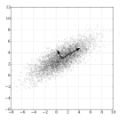
Head-related transfer function (HRTF) plays an important role in the construction of 3D auditory display. This paper presents an individual HRTF modeling method using deep neural networks based on spatial principal component analysis. The HRTFs are represented by a small set of spatial principal components combined with frequency and individual-dependent weights. By estimating the spatial principal components using deep neural networks and mapping the corresponding weights to a quantity of anthropometric parameters, we predict individual HRTFs in arbitrary spatial directions. The objective and subjective experiments evaluate the HRTFs generated by the proposed method, the principal component analysis (PCA) method, and the generic method. The results show that the HRTFs generated by the proposed method and PCA method perform better than the generic method. For most frequencies the spectral distortion of the proposed method is significantly smaller than the PCA method in the high frequencies but significantly larger in the low frequencies. The evaluation of the localization model shows the PCA method is better than the proposed method. The subjective localization experiments show that the PCA and the proposed methods have similar performances in most conditions. Both the objective and subjective experiments show that the proposed method can predict HRTFs in arbitrary spatial directions.
翻译:与头有关的转移功能(HRTF)在构建 3D 听力显示中起着重要作用。本文件展示了使用基于空间主力分析的深神经网络的单个HRTF模型方法; HRTF由一组空间主力组件组成,这些组件与频率和个人依赖的重量相结合。 通过使用深神经网络估计空间主力组件,并将相应重量与数量人类测量参数相匹配,我们以任意的空间方向预测单个HRTF; 客观和主观实验评估了拟议方法、主要组成部分分析方法和通用方法产生的HRTF。 结果表明,拟议方法和五氯苯甲醚方法产生的HRTF比通用方法效果更好。 对于大多数频率而言,拟议方法的光谱扭曲大大小于高频率的五氯苯甲醚方法,但低频率则大得多。对本地化模型的评估表明,常设仲裁院的方法比拟议方法要好。主观本地化实验显示,在多数情况下,常设仲裁院和拟议方法的性能都与一般方法相似。客观和主观实验都显示,拟议方法可以预测空间方向中的HRTF。



















